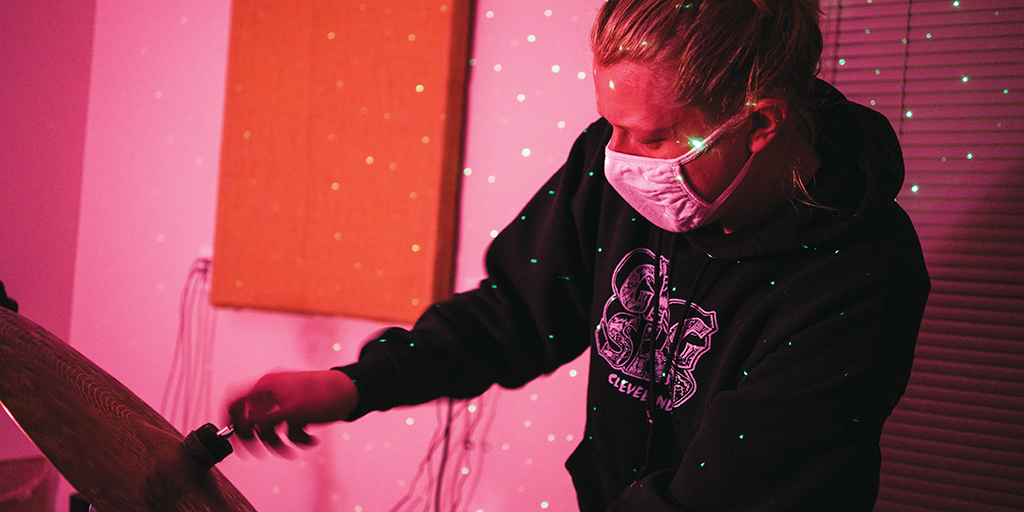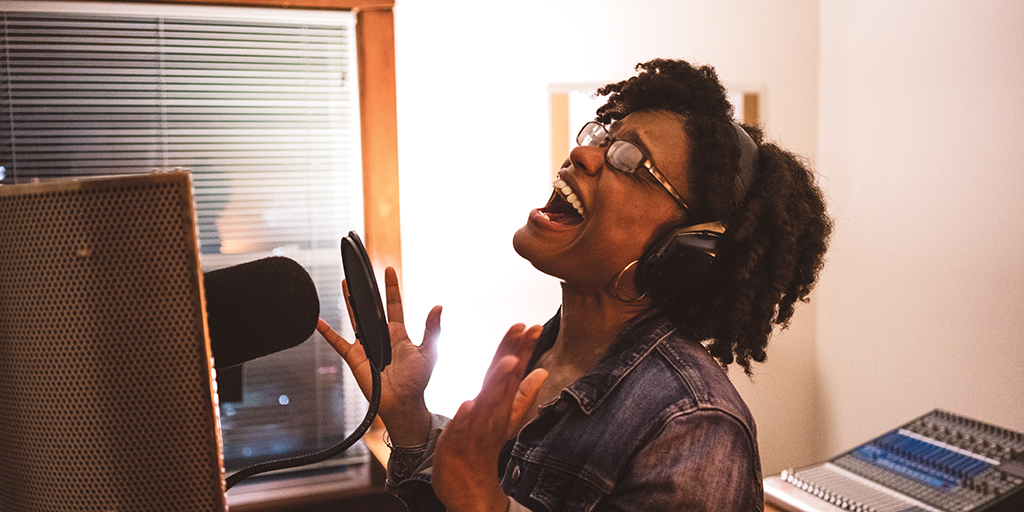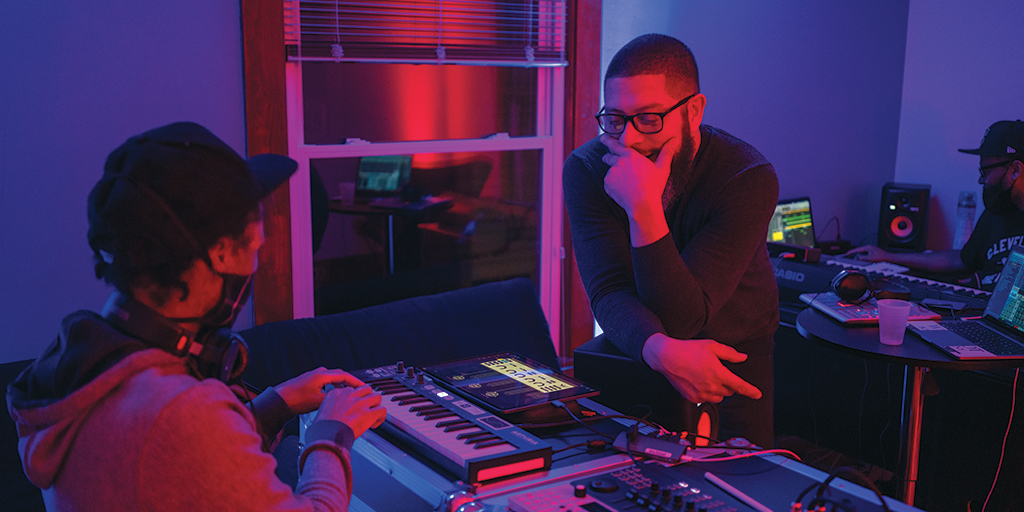Twelve Literary Arts Debuts "In Search of the Land"
by Ken Schneck | Jun. 7, 2021 | 11:00 AM

ILLUSTRATED BY RYAN OLBRYSH
Three different tambourines sit on top of two bongos in front of Elijah Gilmore. The Cleveland percussionist shakes one, smiles and puts it on his lap. He shakes the second, grimaces, and puts it on the floor. He shakes the third and puts it on the ground next to the other instrument. He picks the first tambourine back up, shakes it once more for confirmation, and gives an emphatic nod to Dan Fernandez, a fellow Cleveland percussionist.
The two are sitting across from one another in Fernandez’s third floor attic-turned-recording studio ready to make music. Fernandez nods back to Gilmore in response, turns to face a bank of computer monitors and hits play on a song for which Gilmore is providing additional instrumentation.
The track, “Scratch The Paint Off The Walls,” evokes the grooves of Stevie Wonder, the driving beats of cruising in a Cadillac through Cleveland and soaring background vocals that get lodged in your brain.
As the track plays, Fernandez is a blur of motion adjusting the sound levels in tandem with Gilmore’s performance, their feet tapping in perfect unison. They repeat the process twice more: once with Gilmore playing some shakers and another with him on the bongos. The two pass energy back-and-forth in a well-practiced and comfortable routine, one you would expect of two of the most accomplished and sought-after percussionists in the city. But, for this new musical journey they’re both embarking on, they’ve only just met an hour before, never having worked together before.
They are contributing to In Search of the Land, a collaborative and eclectic album that is part poetry and part music. Sponsored by Twelve Literary Arts — a Cleveland-based literary arts and education nonprofit — the project has assembled more than 60 poets, musicians, singers, engineers and voices who either currently reside in or have roots in Cleveland, all for a musical exploration of the city’s story in a way that has never been done before.
“These tracks capture a social and political zeitgeist of this particular moment in time,” says Daniel Gray-Kontar, founder and executive artistic director of Twelve Literary Arts. “We want to tell the story of what it is to be in search of freedom and opportunity for all people, a story of Cleveland from those who actually live here.”
Debuting June 19, the 12-track album is an unabashed celebration of Blackness that arrives on the nationally celebrated Juneteenth anniversary of the end of slavery. Inspired by the poems of young Black women under the age of 25, the album created by and featuring predominantly Black musicians working in genres of jazz, hip-hop, rap and acoustic pop contains a narrative thread that speaks to the soul of Cleveland.
“Every moment on this album communicates the soulful quality of this town,” says Gray-Kontar. “Cleveland is a city with soul and we want to honor that.”

For years, Gray-Kontar had been batting around the idea of creating an album inspired by the work of the young poets of Twelve Literary Arts. As someone helming an organization with a mission of creating space for individuals to dream, write and teach with a focus on social justice and equity, he had long wanted to create a new platform that centralized Cleveland’s identity through the eyes of a younger generation.
“Despite Cleveland’s rich literary traditions, there has never been a professional-grade recording of the sounds and words of this city and I have long wanted to change that,” says Gray-Kontar.
But it wasn’t until a chance meeting in 2018 that he found the partnership that would make the recording a reality. That year, Gray-Kontar attended a local Fourth of July barbecue and struck up conversation with DJ Cleveland Browne and her husband Terrel Denson Wallace, better known as Tall Black Guy. Gray-Kontar knew Wallace’s reputation as a world-renowned producer and Detroit beat icon who had worked with such luminaries as DJ Jazzy Jeff, Questlove and Gilles Peterson. But as he spoke with Wallace, he discovered something deeper than Wallace’s musical accolades.
“There was just something about Terrel, the similar way we talked about Detroit and Cleveland and how the energy was flowing,” Gray-Kontar remembers. “I knew I had to work with him.”
In the spring of 2019, Gray-Kontar learned about a funding opportunity with the Joyce Foundation, a nonpartisan private foundation that aims to advance racial equity and economic mobility for the next generation in the Great Lakes region. He immediately started crafting a proposal to create a project that would musically tell Cleveland’s story of being one of the most racially segregated cities in America with regard to geography, and told from the perspective of youth and adult poets, musicians, vocalists and residents. He specified in the proposal that he was looking for a producer and remixer who matches a Midwest sensibility with a technical and musical virtuosity to remix the current reality in which these artists live. Enter: Tall Black Guy.
“No one fit the profile for this transformative project better than Terrel,” says Gray-Kontar.
For Wallace, the opportunity to create an album inspired by a sense of place was right in his wheelhouse. 8 Miles to Moenart, his 2013 debut full-length album, pays homage to the Moenart block in Detroit where Wallace grew up. Although he had established himself as an influential producer, Wallace had never before taken on a project with the scope that Gray-Kontar was proposing: collaborating on every aspect of production from concept development to talent recruitment and coordination. After receiving funding in the winter of 2019, the project was set to begin last spring. But then the pandemic hit, providing further challenges.
“This is by far the most demanding thing I have ever done,” says Wallace. “But I also immediately saw the potential for collaboration and brotherhood and told Daniel, ‘Whatever you need me to do.’ ”

Hard not to lose your voice
In the midst of Cleveland.
Hard to find your voice
in the midst of Cleveland.
Hard not to mimic someone else’s
voice and mistake it for yours
in the midst of Cleveland.
In chaos.
That’s the realness.
The illness.
Cleveland always got the flu.
When Mary Barrett wrote her poem “Blackwards” as a 17-year-old high school senior in 2017, she set out to explore the tension between segregation and unification as part of Gray-Kontar’s creative writing class at the Cleveland School for the Arts. She wanted to craft a poem that reflected the reality of the various lived experiences in her home city.
“There are so many different languages spoken all over Cleveland and I wanted to channel those differences into something powerful,” remembers Barrett, now the youth program coordinator at Twelve Literary Arts.
“Blackwards” is the kind of poem Gray-Kontar needed to serve as the intro for In Search of the Land.
“That poem sets the context for a youthful perspective of what Cleveland is: a city of contradictions that can be what we want it to be if only we can work together,” says Gray-Kontar. “That theme of collaboration is what this album is all about.”
Barrett’s poem is emblematic of a key element of In Search of the Land, one which Gray-Kontar mined from the core mission of Twelve Literary Arts.
“We knew that poetry and storytelling needed to form the spine of the album and needed to be the basis of all of the stories that were told,” he says.
But Gray-Kontar and Wallace didn’t want just any poems to inspire the songs. For this project, they specifically focused on poems written by young Black women under the age of 25, women like Barrett. The prospect of amplifying these particular voices further set In Search of the Land apart from any past efforts to capture the sounds of Cleveland.
“These poems represent beginnings of young women coming into consciousness, merging their capacity to weave words around their early experiences about place,” explains Gray-Kontar. “This is a very different thing than adults articulating their relationship to place because what you’re getting here is a raw emotion about what it is like to live here.”

In spring 2020, Gray-Kontar invited 20 Cleveland youth connected to Twelve Literary Arts to share their poems over an open mic Zoom conference. Wallace, who was living near Washington, D.C., at the time, listened in on the call with the goal of selecting a range of poems representing myriad voices, cadence and tones.
“Hey Hood” by Tiyana Williams explored reconciling personal identity with others’ negative perceptions of their Cleveland neighborhoods.
“Red Line Kid” by Deija Vinson spoke to an individual’s capacity to dream in the face of the government sponsored divestment in Cleveland’s predominantly Black zip codes.
Wallace invited a few of these poets to a follow-up session to have them re-read their poetry over music he had prepared.
“I knew that when you read words over music like Lee Morgan and Alice Coltrane, it would evoke more layers of meaning and that’s exactly what happened with those poems,” says Wallace.
Gray-Kontar and Wallace emerged with seven recorded poems which served as their call for artists. They uploaded the recordings online along with instructions for contributors to use the poems as inspiration to submit work. Leveraging his many contacts across Cleveland, Gray-Kontar called, emailed and posted on social media to cast the widest possible net to bring in talent.
“I wanted everyone to hear about this project, from musicians to singers to beatmakers,” says Gray-Kontar. “We were hopeful people would take notice.”
They received a host of submissions from artists including Fernandez, Cleveland keyboardist Eli Hanley and hip-hop artist Tommy Sheridan, all of whom uploaded a wide range of possible sounds — from jazz to folk and soul. For Gray-Kontar and Wallace, it wasn’t about finding completed works, but instead searching for limitless possibilities for collaboration.
“Take Tommy Sheridan, who goes by Broken Keys,” says Gray-Kontar. “His musical dexterity floored us and that’s what these submissions were all about: What can you sound like?”
Through the submissions process, a web of interrelated Cleveland artists began to emerge. Though none of the initial songs that were submitted made it on the final album, Gray-Kontar and Wallace were introduced to a network of talent they immediately wanted to feature, from vocalist Jessica Yafanaro, to the melodic and funky Malik Hayes, known as 2ssaint, and Cathalyn Roberts, lead vocalist and bassist of The Katy, all of whom ended up performing on the album.
“There are a lot of extremely talented, skilled and gifted artists that are not heard enough because Cleveland to me speaks in whispers,” says Barrett. “This was an incredible opportunity to be part of an album that feels like Cleveland shouting for something.”

Ngina Fayola and Emily Keener have nothing but praise for each other’s talent. The two Cleveland singers worked together on the track “Why Not Give Our Best to Love?” an acoustic song Fayola originally wrote while living in Tennessee in 2012 but rerecorded for In Search of the Land with new layers of regional meaning. The track opens with the sound of birds, a nod to Minnie Riperton’s “Lovin’ You,” before launching into one of the more acoustic tracks on the album and an overall warmth in tone.
“This song definitely cries for unity in Cleveland where we are a very divided and segregated city, not just in art, but beyond,” explains Fayola. “The lyrics remind us all that the best thing and easiest thing to do is to love.”
Keener was one of the artists who originally submitted to Gray-Kontar’s open call. He and Wallace immediately knew they wanted her indie folk sound on the album and sent Keener Fayola’s track to inquire about potential collaboration. Although the 22-year-old Keener had never worked with the 44-year-old Fayola, Keener knew she could add something special to the background vocals.
“When I first heard it, I felt this strong desire to provide a blanket of sound to lift up what Ngina was doing vocally and give it a warm hug and embrace for your ears,” says Keener. “I wanted to support rather than take away from this remarkable song.”
Even more remarkable? Keener and Fayola have never met in real life. Fayola recorded her vocals in the Twelve Literary Arts studio and in her home in late March, while Keener recorded hers in a closet-turned-recording-space in her Wakeman apartment. The result is a track that made both quick to appreciate the other’s abilities, even if they’ve never been in the same room.
“That perfect blend of our voices is what this is all about,” says Fayola. “There can be a collective of creative minds here in Cleveland if there is space for those joys and energies to come together as they did here.”
The first-time musical partnership between Fayola and Keener was not the outlier experience for artists on In Search of the Land. In fact, putting together musicians who had never worked together was a design feature inspired by a musical collective with one of Wallace’s most famous collaborators.

“DJ Jazzy Jeff hosts a retreat where he puts different artists together in a room to see what you could create together when you trust in someone else’s music,” says Wallace. “It’s like, ‘You’re dope at what you do. I’m dope at what I do. How can we come together to make something even more dope?’ ”
Over the course of a few months in late 2020 and early 2021, Gray-Kontar and Wallace held two jam sessions, converting every possible space of Twelve Literary Arts’ second-floor headquarters into a recording studio, a makeshift Hitsville U.S.A., right here in Cleveland.
The first session in November gathered Fernandez, Hanley and Buscrates, a Pittsburgh electronic DJ and producer. To provide social distance, all of the artists were set up in different rooms with speakers so they could hear the music being created by the others in separate rooms.
“You had Dan Fernandez’s drumming laying a foundation underneath Buscrates’ funk grooves and Eli Hanley coming in as a piano virtuoso,” says Gray-Kontar. “We cranked out about 16 concepts!”
The second jam was held in March and featured a dozen musical artists over the course of two days. These sessions included vocalists Donnie Lynee and Mariama Whyte, who had not previously worked together. The artists spent the first day free-flowing and experimenting with sound and lyricism. On the second day, they analyzed what they created. Gray-Kontar describes that second jam as more concentrated, producing six musical concepts and one defined track.
“That jam resulted in ‘Higher,’ a seven-minute odyssey that evokes the feeling of Flora Purim, some George Duke, all mixed in with some Earth, Wind & Fire,” says Gray-Kontar. “It’s a real spiritual journey.”
Gray-Kontar and Wallace refer to the process of assembling the album as putting together a puzzle, with pieces scattered all across Cleveland, needing only a nudge here and there to put them together. Some musicians came to Twelve Literary Arts to record while others laid down tracks in home studios like Fernandez’s attic or Keener’s closet. Along the way, Wallace had a demonstrable curiosity, pushing each artist to uncharted territory.
While working with hip-hop and soul artist Peachcurls, Wallace learned the artist’s father was seriously ill in the hospital. Wallace sat with him, listening to his story, and helped guide him to put that emotion right back into the song. The track that emerged and will ultimately land on the final album was “Scratch The Paint Off The Wall.”
“That song is Peachcurls from the perspective of his father, taking us all the way back to what the OGs would listen to in Cleveland back in the day,” says Gray-Kontar. “That was Terrel, getting the best out of each and every artist.”

The free album will release June 19 on Bandcamp, SoundCloud and twelvearts.org. But the public will have an opportunity to experience the magic of In Search of the Land through a livestream concert June 18 with the producers pulling together as many artists as possible to promote the album.
The final set of tracks run the gamut of musical styles, but also cover some of Cleveland’s most complicated issues. “The Awakening” delves deep into the hardships encountered in East Cleveland, while the album culminates in “Black Gold,” which Gray-Kontar describes as the perfect expression of the album’s purpose.
“That song is about an expression of Blackness and of unity,” says Gray-Kontar. “If these artists can come together as they have done to show that respect, that equity and that equality that needs to happen for Black folks, then that seed of hope can expand to a feeling of unity for all of Cleveland to experience.”
The album features spoken word interludes between musical tracks: poems, words from historical figures such as Carl Stokes and more. For “Black Gold,” they recorded children singing in kindergarten, first grade and second grade at Daniel E. Morgan School.
“[The principal] was able to pull a group of young children together and bring them to us so they could talk about what Blackness means to them and then to also sing that they are golden,” says Gray-Kontar. “Them being excited about singing — that was incredibly powerful.”
Gray-Kontar and Wallace are hoping that the experience of creating this album inspires the contributing artists to continue to collaborate. From Fernandez and Gilmore, to Fayola and Keener, to Lynee and Whyte, the producers have been encouraging these musicians to rehearse together, share ideas and support each other. Gray-Kontar says that it is through these authentic partnerships that solidarity is formed and movements are shaped. That lifting up of Black voices when they need to be heard, both nationally and most definitely here in Cleveland, is what’s needed most now.
“This album shows that when we work together with those we don’t know, we really are making a better Land,” says Gray-Kontar.
For more updates about Cleveland, sign up for our Cleveland Magazine Daily newsletter, delivered to your inbox six times a week.
Cleveland Magazine is also available in print, publishing 12 times a year with immersive features, helpful guides and beautiful photography and design.
Trending
-
1
-
2
-
3
-
4
-
5










